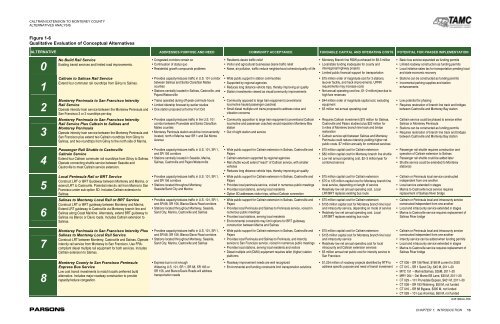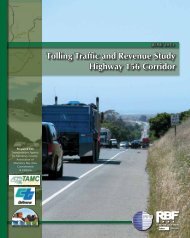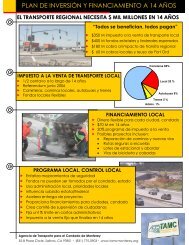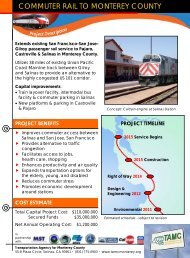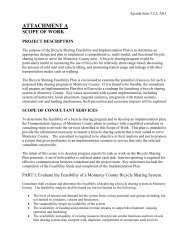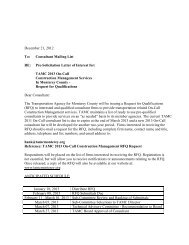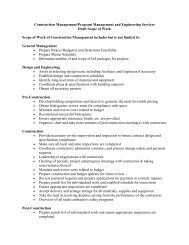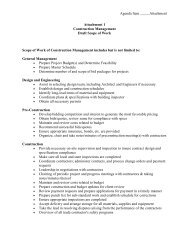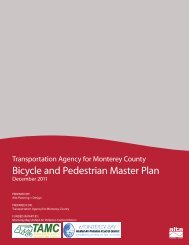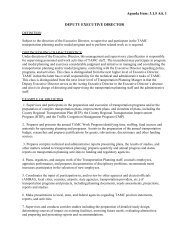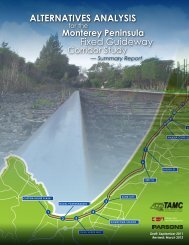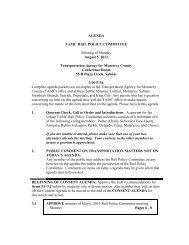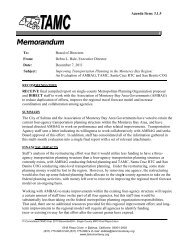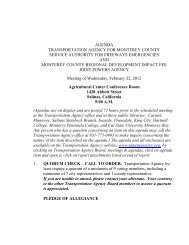Commuter Rail Extension Alternatives Analysis - Transportation ...
Commuter Rail Extension Alternatives Analysis - Transportation ...
Commuter Rail Extension Alternatives Analysis - Transportation ...
Create successful ePaper yourself
Turn your PDF publications into a flip-book with our unique Google optimized e-Paper software.
CALTRAIN EXTENSION TO MONTEREY COUNTYALTERNATIVES ANALYSISFigure 1-6Qualitative Evaluation of Conceptual <strong>Alternatives</strong>ALTERNATIVE ADDRESSES PURPOSE AND NEED COMMUNITY ACCEPTANCE FUNDABLE CAPITAL AND OPERATING COSTS POTENTIAL FOR PHASED IMPLEMENTATION0No Build <strong>Rail</strong> ServiceExisting transit services and limited road improvements.• Congested corridors remain so• Continuation of status quo• Residential growth compounds problems• Residents desire traffic relief• Visitor and agricultural businesses desire traffic relief• Noise, air pollution, traffic reduce neighborhood cohesion/quality of life• Monterey Branch line ROW purchased for $9.3 million• Local/state funding inadequate for county andinterregional highway projects• Limited public financial support for transportation• Basic bus service expanded as funding permits• Limited roadway construction as funding permits• Local initiative sales tax for transportation pending localand state economic recovery12Caltrain to Salinas <strong>Rail</strong> ServiceExtend four commuter rail roundtrips from Gilroy to Salinas.Monterey Peninsula to San Francisco Intercity<strong>Rail</strong> ServiceOperate intercity train service between the Monterey Peninsula andSan Francisco 2 or 3 roundtrips per day.• Provides capacity/reduces traffic in U.S. 101 corridorbetween Salinas and Santa Clara/San Mateocounties• Stations centrally located in Salinas, Castroville, andPajaro/Watsonville• Trains operated during off-peak commute hours• Limited ridership forecast by earlier studies• One station proposed at former Fort Ord• Wide public support in station communities• Supported by regional agencies• Reduces long distance vehicle trips, thereby improving air quality• Station investments viewed as visual/community improvements• Community opposed to large train equipment (conventionallocomotive hauled passenger coaches)• Small diesel multiple unit trains proposed to address noise andvibration concerns• $75 million order of magnitude cost for 3 stations,layover facility, and track improvements. UPRRrequirements may increase costs• Net annual operating cost low, $1–2 million/year due tohigh fare revenues• $44 million order of magnitude capital cost, excludingequipment• $5 million net annual operating cost• Stations can be constructed as funding permits• Incremental parking supplies and stationenhancements• Low potential for phasing• Requires restoration of branch line track and bridgesbetween Castroville and Monterey Bay station3Monterey Peninsula to San Francisco Intercity<strong>Rail</strong> Service Plus Caltrain to Salinas andMonterey PeninsulaOperate intercity train service between the Monterey Peninsula andSan Francisco plus extend two Caltrain roundtrips from Gilroy toSalinas, and two roundtrips from Gilroy to the north side of Marina.• Provides capacity/reduces traffic in the U.S. 101corridor between Prunedale and Santa Clara/SanMateo counties• Monterey Peninsula station would be inconvenientlylocated, north of Marina near SR 1 and Del MonteAvenue• Community opposition to large train equipment (conventional Caltrainlocomotive and passenger coaches) would reposition Monterey Baystation• Out of sight station and service• Requires Caltrain investment ($75 million for Salinas,Castroville and Pajaro studies) plus $22 million for5 miles of Monterey branch line track and bridgerestoration• Caltrain service split between Salinas and MontereyPeninsula could reduce ridership yielding higher netpublic costs. $7 million annually for combined services• Caltrain service could be phased to service eitherSalinas or Monterey Peninsula• Stations can be constructed as funding permits• Requires restoration of branch line track and bridgesbetween Castroville and Monterey Bay station4Passenger <strong>Rail</strong> Shuttle to CastrovilleCaltrain ServiceExtend four Caltrain commuter rail roundtrips from Gilroy to Salinas.Operate connecting shuttle service between Seaside andCastroville to meet Caltrain service extension.• Provides capacity/reduces traffic in U.S. 101, SR 1,and SR 156 corridors• Stations centrally located in Seaside, Marina,Salinas, Castroville and Pajaro/Watsonville• Wide public support for Caltrain extension in Salinas, Castroville andPajaro• Caltrain extension supported by regional agencies• <strong>Rail</strong> shuttle would extend “reach” of Caltrain service, with smallervehicles• Reduces long distance vehicle trips, thereby improving air quality• $75 million capital cost for Caltrain extension• $82 million capital cost for Monterey branch line shuttle• Low net annual operating cost, $2–3 million/year forcombined service• Passenger rail shuttle requires construction andoperation of Caltrain extension to Salinas• Passenger rail shuttle could be added later• Shuttle service could be extended to Montereystation(s)5Local Peninsula <strong>Rail</strong> or BRT ServiceConstruct LRT or BRT Guideway between Monterey and Marina, orextend LRT to Castroville. Potential intercity rail from Marina to SanFrancisco under sub-option 5D. Includes Caltrain extension toSalinas.• Provides capacity/reduces traffic in U.S. 101, SR 1,and SR 156 corridors• Stations located throughout Monterey,Seaside/Sand City and Marina• Wide public support for Caltrain extension in Salinas, Castroville andPajaro• Provides local peninsula service, voiced in numerous public meetings• Provides local stations, serving local residents• Option 5D addresses visitor trips, without Caltrain connection• $75 million capital cost for Caltrain extension• $75 to 125 million capital cost for Monterey branch linelocal service, depending on length of service• Relatively low net annual operating cost. LocalLRT/BRT replaces existing bus route• Caltrain or Peninsula local service constructedindependent from one another• Local service extended in stages• Marina to Castroville local service requiresreplacement of Salinas River bridge6Salinas to Monterey Local <strong>Rail</strong> or BRT ServiceConstruct LRT or BRT guideway between Monterey and Marina.Extend LRT guideway to Castroville via Monterey branch line andSalinas along Coast Mainline. Alternately, extend BRT guideway toSalinas via Blanco or Davis roads. Includes Caltrain extension toSalinas.• Provides capacity/reduces traffic in U.S. 101, SR 1,and SR 68, SR 156, Blanco/Davis Road corridors• Stations located throughout Monterey, Seaside,Sand City, Marina, Castroville and Salinas• Wide public support for Caltrain extension in Salinas, Castroville andPajaro• Provides local Peninsula and Salinas to Peninsula service, voiced innumerous public meetings• Provides local stations, serving local residents• Environmental constraints may limit options for BRT guidewayconstruction between Marina and Salinas• $75 million capital cost for Caltrain extension• $155 million capital cost for Monterey branch line localand intracounty service, depending on mode of service• Relatively low net annual operating cost. LocalLRT/BRT replaces existing bus route• Caltrain or Peninsula local and intracounty serviceconstructed independent from one another• Local and intracounty service extended in stages• Marina to Castroville service requires replacement ofSalinas River bridge7Monterey Peninsula to San Francisco Intercity PlusSalinas to Monterey Local <strong>Rail</strong> ServiceConstruct LRT between Monterey, Castroville and Salinas. Operateintercity rail service from Monterey to San Francisco. Use FRAcompliantdiesel multiple rail equipment for both services. IncludesCaltrain extension to Salinas.• Provides capacity/reduces traffic in U.S. 101, SR 1,and SR 68, SR 156, Blanco/Davis Road corridors• Stations located throughout Monterey, Seaside,Sand City, Marina, Castroville and Salinas• Wide public support for Caltrain extension in Salinas, Castroville andPajaro• Provides local Peninsula and Salinas to Peninsula, and intercityservice to San Francisco service, voiced in numerous public meetings• Provides local stations, serving local residents and visitors• Diesel multiple unit (DMU) equipment requires taller (higher) stationplatforms• $75 million capital cost for Caltrain extension• $155 million capital cost for Monterey branch line localand intracounty service• Relatively low net annual operating cost for localintracounty and Caltrain extension services• $5 million annual net public cost for intercity service toSan Francisco• Caltrain or Peninsula local and intracounty serviceconstructed independent from one another• Intercity service can be added when funding permits• Local and intracounty service extended in stages• Marina to Castroville service requires replacement ofSalinas River bridge8Monterey County to San Francisco PeninsulaExpress Bus ServiceLow cost transit investments to match locally preferred buildalternative. Includes major roadway construction to providecapacity/reduce congestion.• Express bus is not enoughWidening U.S. 101, SR 1, SR 68, SR 183 orSR 156, and Blanco/Davis Roads will addresstransportation needs• Roadway improvement needs are well recognized• Environmental and funding constraints limit transportation solutions• $1,234 million of roadway projects identified by RTP toaddress specific purpose and need of transit investment• CT 036 – SR 156 West, $198 M current to 2020• CT 015 – SR 1 Sand City, $45 M, 2011–20• MYC 151 – Marina/Salinas, $35M, 2011–20• MRY 004 – Del Monte EB Lane, $30 M, 2011–20• CT 029 – 101 Prunedale Bypass, $421 M, 2011–30• CT 038 – SR 183 Widening, $50 M, not funded• CT 016 – SR 68 Bypass, $395 M, not funded• CT 028 – 101-Las Aromitas, $60 M, not funded645188AA-056parsons CHAPTER 1: INTRODUCTION 13


